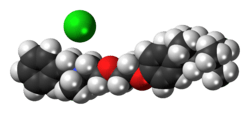Benzethonium chloride
Benzethonium chloride, also known as hyamine is a synthetic quaternary ammonium salt. This compound is an odorless white solid, soluble in water. It has surfactant, antiseptic, and anti-infective properties, and it is used as a topical antimicrobial agent in first aid antiseptics. It is also found in cosmetics and toiletries such as mouthwashes, anti-itch ointments, and antibacterial moist towelettes. Benzethonium chloride is also used in the food industry as a hard surface disinfectant.[1]
 | |
 | |
| Names | |
|---|---|
| Preferred IUPAC name
N-Benzyl-N,N-dimethyl-2-{2-[4-(2,4,4-trimethylpentan-2-yl)phenoxy]ethoxy}ethanaminium chloride | |
| Systematic IUPAC name
Benzyldimethyl(2-{2-[4-(2,4,4-trimethylpentan-2-yl)phenoxy]ethoxy}ethyl)azanium chloride | |
| Identifiers | |
CAS Number |
|
3D model (JSmol) |
|
Beilstein Reference |
3898548 |
| ChEBI | |
| ChEMBL | |
| ChemSpider | |
| ECHA InfoCard | 100.004.073 |
| EC Number |
|
| KEGG | |
| MeSH | Benzethonium |
PubChem CID |
|
| RTECS number |
|
| UNII | |
| UN number | 2923 |
CompTox Dashboard (EPA) |
|
InChI
| |
SMILES
| |
| Properties | |
Chemical formula |
C27H42ClNO2 |
| Molar mass | 448.09 g·mol−1 |
| Melting point | 163 °C (325 °F; 436 K) |
Solubility in water |
40 g dm−3 (at 20 °C) |
| Pharmacology | |
| D08AJ08 (WHO) R02AA09 (WHO) | |
| topical | |
| Legal status |
|
| Hazards | |
| GHS pictograms |    |
| GHS Signal word | Danger |
GHS hazard statements |
H301, H314, H400 |
GHS precautionary statements |
P273, P280, P305+351+338, P310 |
Except where otherwise noted, data are given for materials in their standard state (at 25 °C [77 °F], 100 kPa). | |
| Infobox references | |
Uses
Antimicrobial
Benzethonium chloride exhibits a broad spectrum of microbiocidal activity against bacteria, fungi, mold and viruses. Independent testing shows that benzethonium chloride is highly effective against such pathogens as methicillin-resistant Staphylococcus aureus, Salmonella, Escherichia coli, Clostridium difficile, hepatitis B virus, hepatitis C virus, herpes simplex virus (HSV), human immunodeficiency virus (HIV), respiratory syncytial virus (RSV), and norovirus.
The US Food and Drug Administration (FDA) specifies that the safe and effective concentrations for benzethonium chloride are 0.1-0.2% in first aid products.[2] Aqueous solutions of benzethonium chloride are not absorbed through the skin. It is not approved in the US and Europe for use as a food additive. Being a quaternary ammonium salt, it is more toxic than negatively charged surfactants.[3] However, in a two-year study on rats, there was no evidence of carcinogenic activity.[4]
It is available under trade names Salanine, BZT, Diapp, Quatrachlor, Polymine D, Phemithyn, Antiseptol, Disilyn, Phermerol, and others.[5] It is also found in several grapefruit seed extract preparations[6] and can be used as a preservative, such as in the anaesthetics ketamine[7] and alfaxalone.[8]
Other uses
In addition to its highly effective antimicrobial activity, benzethonium chloride contains a positively charged nitrogen atom covalently bonded to four carbon atoms. This positive charge attracts it to the skin and hair. This contributes to a soft, powdery after-feel on the skin and hair, as well as long-lasting persistent activity against micro-organisms. Also, this positively charged hydrophilic part of the molecule makes it a cationic detergent.[9]
Benzethonium chloride is also used to titrate the quantity of sodium dodecyl sulfate in a mixture of sodium dodecyl sulfate, sodium chloride and sodium sulfate, using dimidium bromide-sulphan blue as an indicator.[10]
It precipitates as turbidity with anionic polymers in aqueous solution, allowing it to be used to estimate the amount of such polymers present in a sample. This test is used in commercial and industrial water treatment, where polyacrylates, polymaleates, and sulfonated polymers are commonly employed as dispersants.
Methylbenzethonium Chloride
A related compound (25155-18-4 ) is used to treat Leishmania major infections.
Regulation
Some data has suggested that long-term exposure to antibacterial ingredients could contribute to bacterial resistance or hormonal effects. Furthermore, there is little evidence that the use of such ingredients in consumer soaps is actually more effective than plain soap and water. In September 2016, the Food and Drug Administration issued a ban on nineteen consumer antiseptic wash ingredients. A ruling on benzethonium chloride, along with two other similar ingredients, was deferred for a year to allow for more data collection.[11]
References
- Record in the Household Products Database of NLM
- Tentative final monograph (21CFR 333) Archived May 22, 2014, at the Wayback Machine
- Data Sheets
- National Toxicology, Program (1995). "NTP Toxicology and Carcinogenesis Studies of Benzethonium Chloride (CAS No. 121-54-0) in F344/N Rats and B6C3F1 Mice (Dermal Studies)". National Toxicology Program technical report series. 438: 1–220. PMID 12595925.
- Sciencelab.com, Benzethonium chloride MSDS
- Takeoka, G.; Dao, L.; Wong, R. Y.; Lundin, R.; Mahoney, N. (2001). "Identification of Benzethonium Chloride in Commercial Grapefruit Seed Extracts". Journal of Agricultural and Food Chemistry. 49 (7): 3316–20. doi:10.1021/jf010222w. PMID 11453769.
- Coates, K. M.; Flood, P. (2001). "Ketamine and its preservative, benzethonium chloride, both inhibit human recombinant α7 and α4β2 neuronal nicotinic acetylcholine receptors in Xenopusoocytes". British Journal of Pharmacology. 134 (4): 871–9. doi:10.1038/sj.bjp.0704315. PMC 1573008. PMID 11606328.
- https://dailymed.nlm.nih.gov/dailymed/fda/fdaDrugXsl.cfm?setid=2a8e4d17-3ff3-4aa3-a990-7cb012a3123a&type=display
- TOXNET
- European Pharmacopoeia 5.0 Monographs (PDF). European Pharmacopoeia Commission. p. 2440.
- "FDA issues final rule on safety and effectiveness of antibacterial soaps". Food & Drug Administration. U.S. Food and Drug Administration. Retrieved February 7, 2017.